The Antimetabolite Drugs Market is estimated to be valued at USD 5.9 billion in 2025 and is projected to reach USD 7.1 billion by 2035, registering a compound annual growth rate (CAGR) of 1.8% over the forecast period.
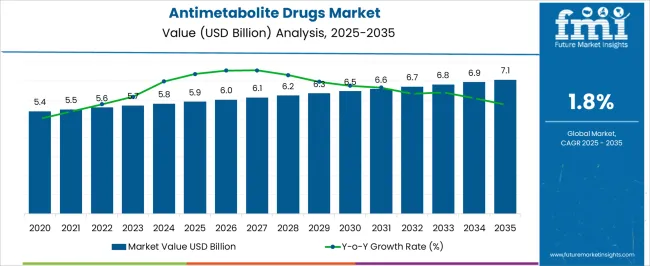
| Metric | Value |
|---|---|
| Antimetabolite Drugs Market Estimated Value in (2025 E) | USD 5.9 billion |
| Antimetabolite Drugs Market Forecast Value in (2035 F) | USD 7.1 billion |
| Forecast CAGR (2025 to 2035) | 1.8% |
The antimetabolite drugs market is experiencing robust growth, supported by the rising global burden of cancer and autoimmune disorders, and a strong clinical pipeline of targeted therapies. These drugs, which interfere with DNA and RNA synthesis, are being increasingly prioritized in chemotherapy regimens due to their cell cycle specificity and proven efficacy across multiple malignancies.
Pharmaceutical companies are investing in next-generation antimetabolites with reduced toxicity profiles and improved pharmacokinetics to support long-term treatment adherence. Oral drug delivery is being favored for its patient-centric benefits, and healthcare systems are moving toward home-based care models, accelerating oral antimetabolite adoption.
At the same time, global regulatory bodies are expediting oncology drug approvals, especially for life-threatening diseases, further accelerating market entry. Continued focus on personalized medicine and combination therapies, along with R&D investment in synthetic analogs and biosimilars, is expected to unlock new opportunities in both developed and emerging markets.
The market is segmented by Drug Class, Route Of Administration, Application, and Distribution Channel and region. By Drug Class, the market is divided into Pyrimidine Compounds, Purine Compounds, Folate Antagonists, and Demethylation Agents. In terms of Route Of Administration, the market is classified into Oral, Intravenous, and Intramuscular. Based on Application, the market is segmented into Cancer Therapeutic, Cardiac Therapeutic, and Arthritis Therapeutic. By Distribution Channel, the market is divided into Retail Sales, Hospital Pharmacies, Retail Pharmacies, Drug Stores, and Online Pharmacies. Regionally, the market is classified into North America, Latin America, Western Europe, Eastern Europe, Balkan & Baltic Countries, Russia & Belarus, Central Asia, East Asia, South Asia & Pacific, and the Middle East & Africa.
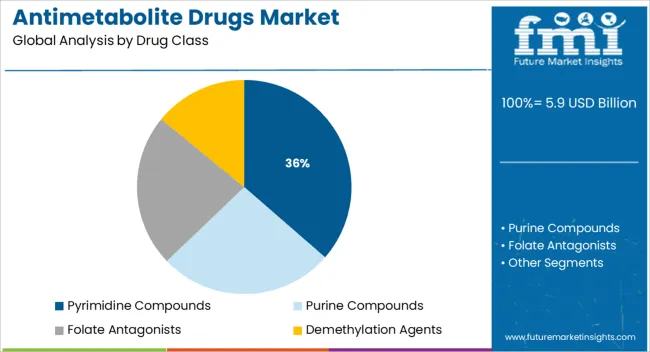
Pyrimidine compounds are projected to account for 36.4% of the total market revenue in 2025, making them the leading drug class within the antimetabolite category. This dominance is attributed to their broad utility in cancer chemotherapy protocols, where they inhibit thymidylate synthase and disrupt DNA synthesis in rapidly dividing cells.
These compounds have demonstrated consistent efficacy across colorectal, breast, pancreatic, and gastrointestinal cancers, supporting their continued use as a foundational element in treatment regimens. The well-established safety and efficacy profiles of key pyrimidine analogs, along with ongoing efforts to develop modified derivatives with improved tumor targeting and reduced side effects, have reinforced their market position.
Moreover, pyrimidine compounds are integral to both monotherapy and combination protocols, increasing their therapeutic versatility and sustaining demand from oncology healthcare providers globally.
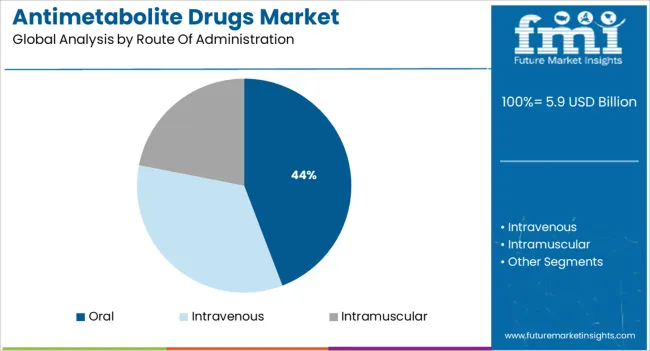
The oral route is anticipated to contribute 44.2% of total market revenue by 2025, maintaining its position as the leading route of administration for antimetabolite drugs. The growing preference for oral formulations is being driven by increased patient convenience, improved compliance, and the ability to manage chronic treatment courses outside of hospital settings.
Healthcare systems are supporting this shift through the expansion of outpatient oncology care models, which prioritize home-based drug administration for improved patient quality of life and cost efficiency. Pharmaceutical innovations have focused on enhancing oral bioavailability, ensuring consistent therapeutic levels, and minimizing gastrointestinal toxicity.
The availability of oral antimetabolites with proven clinical outcomes and robust manufacturing scalability has further enabled their integration into first-line treatment protocols, particularly in oncology and immunosuppressive therapies.
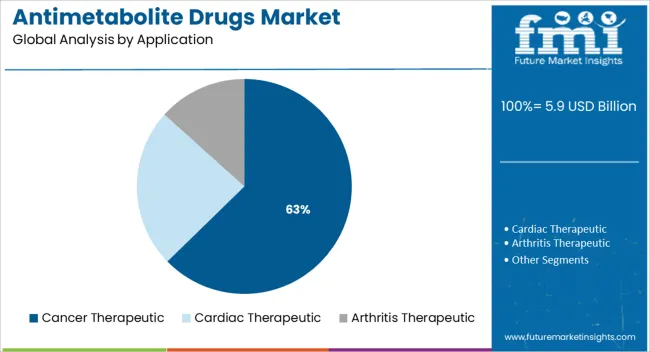
Cancer therapeutic applications are forecast to represent 62.7% of the total antimetabolite drugs market revenue in 2025, making it the dominant application segment. This leadership stems from the critical role of antimetabolites in frontline and adjuvant chemotherapy regimens across various cancer types. These agents are extensively used due to their ability to disrupt DNA replication and cell division, making them highly effective against proliferative cancer cells.
The global rise in cancer incidence, particularly gastrointestinal, hematologic, and breast cancers, has intensified demand for effective and affordable chemotherapeutic options. Antimetabolites have been supported by extensive clinical validation, making them a trusted component in oncological treatment protocols.
Moreover, ongoing trials evaluating antimetabolite-based combinations with immunotherapies and targeted therapies have further strengthened their relevance in modern oncology. Government and institutional support for cancer drug accessibility and oncology infrastructure expansion have also reinforced the segment’s commanding share and growth trajectory.
The rapid development in the fields of oncology and drug delivery is expected to show significant growth in the Antimetabolite Drugs market during the forecast period. Additionally, the increased government investments in cancer treatment and diagnosis, research, and initiative to create awareness about cancer are anticipated to drive the global Antimetabolite Drugs market growth.
Moreover, an increase in unhealthy habits such as smoking, and consumption of tobacco are common factors that can cause cancer. This, in turn, is projected to propel the growth of the Antimetabolite Drugs market. Furthermore, an increase in the spending on research and development for cancer research activities in biotechnology and pharmaceutical firms is expected to boost market growth.
Due to well-established research infrastructure and rising interest in research activities, North America dominated the Antimetabolite Drugs market and is expected to show the same growth in the forecast period. Owing to the increasing research on cancer therapeutic and government supported funding policies, Europe has shown high growth in the Antimetabolite Drugs market.
Followed by Europe, East Asia and South Asia is expected to show the rapid growth over the forecast period. This is due to the increased prevalence of cancer and the focus of the government on the development of the medical infrastructure.
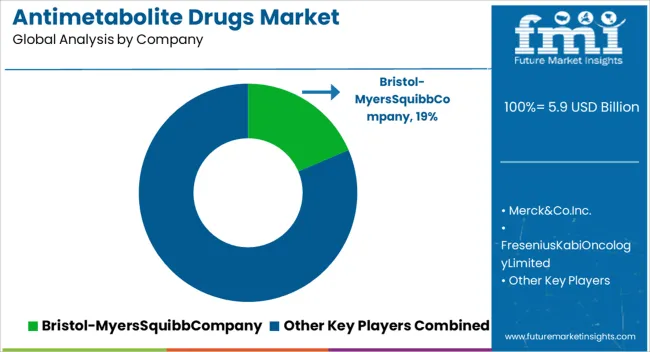
Some of the key players operating in the Antimetabolite Drugs market are Parenteral Drugs Limited., Bristol-Myers Squibb Company, Merck & Co., Inc., Fresenius Kabi Oncology Limited, GlaxoSmithKline plc, Cadila Pharmaceuticals., CELON LABS, Sanofi, Eli Lilly and Company (Lilly), Novartis AG, and Teva Pharmaceutical Industries Ltd.
| Attributes | Details |
|---|---|
| Forecast Period | 2025 to 2035 |
| Historical Data Available for | 2012 to 2024 |
| Market Analysis | USD Million for Value |
| By Drug Class |
Pyrimidine Compounds; Purine Compounds; Folate Antagonists; Demethylation Agents |
| By Route of Administration |
Oral; Intravenous; Intramuscular |
| By Application |
Cancer Therapeutic; Cardiac Therapeutic; Arthritis Therapeutic |
| By Distribution Channel |
Retail Sales; Hospital Pharmacies; Retail Pharmacies; Drug Stores; Online Pharmacies |
| By Region |
North America; Latin America; Europe; East Asia; South Asia; Oceania; Middle East & Africa |
| Key Players |
Parenteral Drugs Limited.; Bristol-Myers Squibb Company; Merck & Co., Inc.; Fresenius Kabi Oncology Limited; GlaxoSmithKline plc; Cadila Pharmaceuticals; CELON LABS; Sanofi SA; Eli Lilly and Company (Lilly); Novartis AG; Teva Pharmaceutical Industries Ltd. |
The global antimetabolite drugs market is estimated to be valued at USD 5.9 billion in 2025.
The market size for the antimetabolite drugs market is projected to reach USD 7.1 billion by 2035.
The antimetabolite drugs market is expected to grow at a 1.8% CAGR between 2025 and 2035.
The key product types in antimetabolite drugs market are pyrimidine compounds, purine compounds, folate antagonists and demethylation agents.
In terms of route of administration, oral segment to command 44.2% share in the antimetabolite drugs market in 2025.






Full Research Suite comprises of:
Market outlook & trends analysis
Interviews & case studies
Strategic recommendations
Vendor profiles & capabilities analysis
5-year forecasts
8 regions and 60+ country-level data splits
Market segment data splits
12 months of continuous data updates
DELIVERED AS:
PDF EXCEL ONLINE
Drugs Glass Packaging Market Analysis - Size, Share, and Forecast Outlook 2025 to 2035
Orphan Drugs Market Size and Share Forecast Outlook 2025 to 2035
Topical Drugs Packaging Market Growth & Forecast 2025 to 2035
Retinal Drugs And Biologics Market
Antiviral Drugs Market Size and Share Forecast Outlook 2025 to 2035
Cytotoxic Drugs Market Analysis – Growth, Trends & Forecast 2025-2035
3D Printed Drugs Market Outlook – Growth, Demand & Forecast 2025-2035
Depression Drugs Market
Parenteral Drugs Packaging Market
Brain Tumor Drugs Market Forecast & Analysis: 2025 to 2035
Infertility Drugs Market Analysis - Size, Share & Forecast 2025 to 2035
Expectorant Drugs Market Trend Analysis Based on Drug, Dosage Form, Product, Distribution Channel, and Region 2025 to 2035
Cannabinoid Drugs Market
Clot Busting Drugs Market Size and Share Forecast Outlook 2025 to 2035
Psychotropic Drugs Market Growth - Industry Trends & Outlook 2025 to 2035
Critical Care Drugs Market Analysis – Trends, Demand & Forecast 2024-2034
Anti-Malarial drugs Market
Fish-Oil Based Drugs Market Analysis – Trends, Share & Growth Forecast 2024-2034
Plasma-Derived Drugs Market
Antithrombotic Drugs Market

Thank you!
You will receive an email from our Business Development Manager. Please be sure to check your SPAM/JUNK folder too.
Chat With
MaRIA